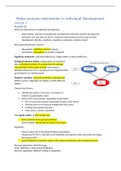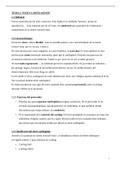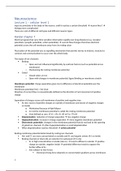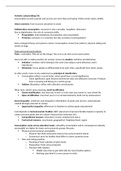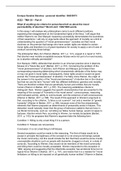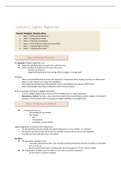Lecture 1:
Ergodicity
What are interventions in individual development:
- Interventions; intervene in problematic development, stimulate positive development
- Individual; one size does not fit all, in both the interventions and the study of them
- Development; identity, emotions, cognitions, autonomy, resilience talent
Self-organizing dynamic systems
- Ideographic; individual systems (unique)
- Nomothetic; populations (ensemble of objects)
Ergodicity continuum= individual differences, single subject to fixed coefficients.
Ecological inference fallacy; interpretation of statistical
data, individual members of a group have the average
characteristics of the group at large (stereotypes).
Statistical inferences from a group level are inappropriately
generalized to an individual level.
Simpson’s paradox= reversed correlation at group level.
Within a group, subgroups can display a totally different
pattern.
Classical test theory;
1. Mental test; discern ‘true score’ on feature of
interest IQ, personality, exam
2. Same test to same person, repeatedly (many times)
Error in each test sessions (distracted, hungry, tired, tense)
Humans learn is not equal to independent test scores
Testing many people one time
More data is a better hypothesis
The ergodic switch the average man
- Every member of the group is identical
- Every member will remain the same in the future
Ergodicity;
- Person= basic unit of sociopsychological organization
- Group level 99.7% CI. Only 68% of all individual correlational values fall within the range;
discrepancy 32%.
- Each individual is a dynamic system with unique architecture and resulting dynamics
Personal replication; A-B-A-B design
Direct replication; more people idiographic
Systemic replication; different setting or population
,Complex dynamic system theory
One size does not fit all;
- We cannot generalize findings on groups to individuals. Not without checking for ergodicity
assumptions.
- Intervention knowledge is based on group-based research; we know little about processes of
change within individuals.
Complex dynamic systems theory can help to understand individual change processes. It is a generic
theory of processes over time, used to understand for example; climate change, artificial intelligence
in swarm robots, animal behavior, criminal networks, immune system responses, psychology
(development and psychopathology).
Why does the same intervention work for some One (problematic) pattern can have different
individuals but not for others underlying mechanisms (which is called
equifinality).
Why is it so hard to find the cause of a mental - Because there is no latent disease, like
disorder depression, that causes all these
symptoms
- Rather, symptoms cause each other and
the resulting pattern is what we call
depression (network theory)
What to Depends on the network of the individual. 3
intervene in options;
1. Symptoms interventions
(temporary change)
2. Interventions in external field
3. Network interventions (lasting
change)
Why are some Because of connectivity of the network.
individuals very Different network structures
resilient while
others are not;
When to intervene? When is change coming? - During a period of increased
fluctuation, experiences may be more
impactful – this is the time
interventions may have the most
impact
- Change to a new state more likely after
fluctuations, critical slowing down. A
win for intervention may also be to
increase fluctuation/flexibility in a state
, In a classical approach to human behavior, there is an assumption of a linear relationship between
variables (input processes output). But, variables are never independent, they influences each
other.
Self-organization can create attractor states; a state the system is drawn to (e.g. ants eventually
choose the fastest route).
Network theory:
- 4 phases
- Two types of networks; connectivity of variables within an individual may differ
Resilient network; activation doesn’t spread that easily. Removing external stressor may
be enough.
Vulnerable network; symptoms are more tightly connected. Activation spreads fast. The
network is self-sustaining, removal of external stressor may not help.
Changing networks;
- Shape of change matters
- Early warning signals that a new pattern is emerging
Increase in fluctuation
Critical slowing down
Lecture 2: Identity development
Developmental perspective on identity;
- Erikson;
Identity versus role confusion
Psychosocial perspective; self in environment
- Marcia;
Made it more concrete
Commitments and exploration
Foreclosed= commitment + no explorations.
Diffused= no commitment + no exploration (carefree
diffused and anxious diffused).
Moratorium= no commitments + exploration.
Searching/exploring for different identity
commitments.
Achieved= commitments + exploration. The individual
has a strong identity but is still a bit flexible.
Identity process models;
- Scales of exploration and commitment; commitment and
exploration are interacting. You can shift between them.
- Typical findings; commitments are good for wellbeing,
exploration only when combined with commitment.
Different types of exploration;
- Exploration in breadth; search for new things to commit to

